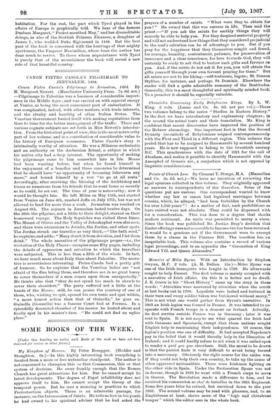CANON PIETRO CASOLA'S PILGRIMAGE TO JERUSALEM, 1494.
Canon Pietro Casola's Pilgrimage to Jerusalem, 1494. By M. Margaret Newest. (Manchester University Press. 7s. 6d. net.) —Pilgrimage to Palestine was a business of considerable import- ance in the Middle Ages; and was carried on with especial energy at Venice, as being the most convenient port of embarkation. It was complicated, indeed, with other matters, with trade interests, and the rivalry and hostility of other Italian States. The Venetian Government busied itself with making regulations from time to time for the better management of the traffic. These and various cognate subjects are set forth in Miss Newett's introduc- tion. From the historical point of view, this is the most noteworthy part of her volume, and is a contribution of considerable value to the history of European commerce. Pietro Casola's story is intrinsically worthy of attention. He was a Milanese ecclesiastic and an authority on the Ambrosian Ritual, a subject in which his native city had a deep interest. The opportunity of making the pilgrimage came to him somewhat late in life. Means had been wanting before, but when he found himself in the enjoyment of a benefice and three canonries he determined that he should have "no opportunity of becoming lukewarm any more," and bound himself by a vow "to go at all costs." Accordingly, after receiving the blessing of the Archbishop and kisses so numerous from his friends that he went home as secretly as he could, he set out. The time of year is noteworthy; now it would be thought late. He left Milan on May 15th, and started from Venice on June 4th, reached Jaffa on July 17th, but was not allowed to land for more than a week. Jerusalem was reached on August 6th. The sojourn in Jerusalem lasted twelve days. On the 26th the pilgrims, not a little to their delight, started on their homeward voyage. The Holy Sepulchre was visited three times. The Mount of Olives and the Valley of Jehoshaphat were also seen, and there were excursions to Jericho, the Jordan, and other spots. The Jordan struck our traveller as very thick,—"like bath mud," he explains, and adds : "Many drank it from devotion, and I let them drink." The whole narrative of the pilgrimage proper—i.e., the visitation of the Holy Places—occupies some fifty pages, including the details of oppression and extortion to which the travellers were subjected. This is less than a fifth of the whole. In fact, we hear much more about Italy than about Palestine. The narra- tive is nevertheless interesting. Pietro Casola had a pretty gift of humour. So he explains that the Venetian ladies are "not afraid of the flies biting them, and therefore are in no great hurry to cover themselves if a man comes upon them unexpectedly." He thinks also that "they do not spend too much in shawls to cover their shoulders." The party suffered not a little at the hands of the Moors ; still, he can praise the courtesy of one of them, who, wishing to spit, opened his own tunic and spat within, "a more honest action than that of G-uinella," he goes on. Guinella (Gonnella) was a famous Court fool at Ferrara. In a splendidly decorated chamber of his master he looked about and finally spat in his master's face. "He could not find an uglier place."






































 Previous page
Previous page